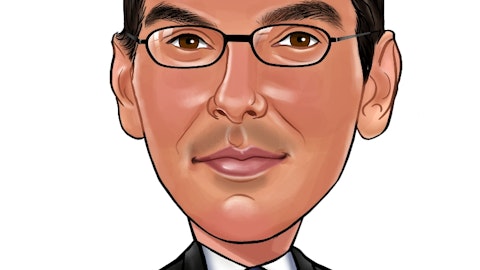BrightSphere Investment Group Inc. (NYSE:BSIG) Q4 2022 Earnings Call Transcript February 2, 2023
Operator: Ladies and gentlemen, thank you for standing by. Welcome to BrightSphere Investment Group Earnings Conference Call and Webcast for the Fourth Quarter 2022. During the call, all participants will be in a listen-only mode. After the presentation, we will conduct a question-and-answer session. Note, this call is being recorded today, Thursday, February 2, 2023, at 11 a.m. Eastern Time. I would now like to turn the call over to Elie Sugarman, Head of Strategy and Corporate Development. Please go ahead.
Elie Sugarman: Good morning, and welcome to BrightSphere’s conference call to discuss our results for the fourth quarter ended December 31, 2022. Before we get started, please note that we may make forward-looking statements about our business and financial performance. Each forward-looking statement is subject to risks and uncertainties that could cause actual results to differ materially from those projected. Additional information regarding these risks and uncertainties appears in our SEC filings, including the Form 8-K filed today containing the earnings release, our 2021 Form 10-K and our Form 10-Q for each of the first, second and third quarters of 2022. Any forward-looking statements that we make on this call are based on assumptions as of today, and we undertake no obligation to update them as a result of new information or future events.

Photo by Romain Dancre on Unsplash
We may also reference certain non-GAAP financial measures. Information about any non-GAAP measures reflected, including a reconciliation of those measures to GAAP measures, can be found on our website along with the slides that we will use as part of today’s discussion. Finally, nothing herein shall be deemed to be an offer or solicitation to buy any investment products. Suren Rana, our President and Chief Executive Officer, will lead the call. And now, I’m pleased to turn the call over to Suren. Suren?
Suren Rana: Thanks, Elie. Good morning, everyone. Thank you for joining us today. As usual, I’ll start off with the financial highlights on Slide 5 of the deck. For Q4 ’22, we reported our highest ever quarterly ENI per share of $0.67, 26.4% higher than $0.53 that we reported for Q4 of 2021. Our sizable share buyback in Q4 of ’21 and Q1 of ’22, more than offset the drop in our earnings from the significant equity market decline in 2022 and the resulting impact on our AUM. We are pleased that throughout this volatile market environment, our investment performance has continued to be strong. As of December 31, ’22, 88%, 87%, 87% and 90% of our strategies by revenue, beat their benchmarks over the prior one, three, five and 10-year periods, respectively.
We also reported second straight quarter of positive net client cash flow with $1.3 billion of net inflows as we saw robust sales across a few different strategies. Our sales pipeline remains healthy with ongoing searches across a range of strategies. Turning to capital management. We had a cash balance of $108 million as of December 31, ’22, after funding $15 million of seed capital for Acadian’s Equity Alternatives platform and fully paying off Acadian’s seasonal credit facility. Acadian generally draws on this facility in the first quarter for 1Q seasonal need, and they fully paid off over the course of the year. As our business continues to generate strong free cash flow, we expect to continue deploying capital to support our organic growth and to buy back shares whenever opportunities come up.
Turning to some highlights for Acadian on Slide 7. Acadian generated $50.9 million of adjusted EBITDA in the fourth quarter of ’22 compared to $87.6 million in the fourth quarter of ’21. The drop in EBITDA compared to 4Q of ’21 was mainly driven by the approximately 20% decline in AUM over the last 12 months due to equity market decline globally and lower performance fees than last year. Turning to Slide 11 for a minute. As a reminder overview of what Acadian’s capabilities are. The top two rows, equity and managed volatility had historically been Acadian’s core capabilities, and that’s where most of our AUM resides currently. The bottom four rows represent the growth initiatives underway. These are all large and growing markets where Acadian systematic approach is particularly suited to serve this demand.
As a quick update on these initiatives. We continue to build out Acadian’s efforts in systematic credit with the core investment team now mostly in place, and we continue to add to the investment model and data and technology infrastructure. We expect to start investing in this strategy in the second half of ’23 with seed capitals. We kickstarted Acadian’s Equity Alternatives platform in Q4 with $15 million of seed capital and have now started to build a track record here. We continue to make further progress on systematic macro with ongoing traction with clients and additional buy ratings from consultants. And we continue to see more investment mandates focused on responsible investing. All these initiatives tap into secular growth markets.
And over time, we expect them to help generate sustained organic growth for Acadian. To conclude with our long-term strategy on Slide 15. We will continue to invest in our core capabilities and leverage our unique quant platform to expand into new areas. We will continue using our free cash flow to support organic growth and for share repurchases whenever opportunities are available, and we remain focused on maximizing shareholder value. Now let me turn the call back to the operator. Happy to answer questions at this point.
See also 25 Countries with the Lowest Corporate Tax Rates and 12 Cheap Biotech Stocks To Buy .
Q&A Session
Follow Brightsphere Investment Group Plc (Old Filings) (NYSE:BSIG)
Follow Brightsphere Investment Group Plc (Old Filings) (NYSE:BSIG)
Operator: Our first question comes from Glenn Schorr with Evercore.
Glenn Schorr: Hi. Thanks very much. So I’m very curious on some of the new build-outs. You talked about the team mostly being paid since systematic credit. So one is, is that the case for Equity Alternatives as well? And then at the highest level, I’m curious of what you see the differences between systematic equity and systematic credit from a process standpoint? And why would Acadian just be getting around to it now? It does seem like a big opportunity. It’s just — it’s not as big in the marketplace. So curious if you could talk to those two things. Thanks.
Suren Rana: Yeah. Hi, Glenn. Thanks. Yeah. You’re right. The team — the core team at least in both these areas is mostly in place. They’re about eight to 10 people in both strategies. There will be more people added as we go in select areas in data, et cetera, but the core team is mostly in place. And what’s happening now is we continue to add more infrastructure, more trading infrastructure, more data infrastructure, particularly in credit. The Equity Alternatives is a little bit ahead, as I mentioned earlier, we’ve already seeded it, and the seed capital is being invested, and we’re building a track record here. Credit, you’re right. It is a big opportunity, at least as large as equity is, and it is a market — that is — it is quant driven.
And so our unique quant capabilities would have an advantage here. What’s come along over the past few years, clearly, this market was a voice market, over the phone market, not as much electronic trading. That’s changed a lot. So there’s more and more electrification of trading here. And that is also, in turn, like more data being available. So that made this market, I would say, more for the taking now for Acadian. And secondly, it’s also as our data has built up, we can leverage a lot of that for credit, it is similar kind of analysis, as you know. So we can leverage a lot of that data. But there was also — we have been on the lookout for a good team for a while and that’s critical. That’s the right fit. People who are — who have the same systematic quant mindset but also have credit experience.
So we were fortunate to really find as we announced a few quarters ago and Scott Richardson, really one of the pioneers in quant credit, who brought on more people with deep experience in the area. So it’s really just a lot of things coming together at the right time, which is a bit of a coup.
Glenn Schorr: Great. Appreciate all that. Thanks.
Operator: Our next question comes from Kenneth Lee with RBC Capital Markets.
Kenneth Lee: Hi. Good morning. Thanks for taking my question. It doesn’t sound like you repurchased any shares in the quarter. So wondering, if you could just comment on any discussions you may have had around potential value enhancing transactions. Thanks.
Suren Rana: Hi, Ken. That is correct that we haven’t purchased any shares in the quarter. We, of course, don’t specifically comment on any conversations. But, yes, from time to time, we are in blackout windows, either, as Elie mentioned, during earnings blackout windows that also if we have any non-public material conversations.




